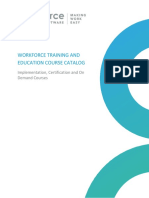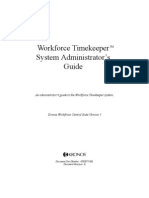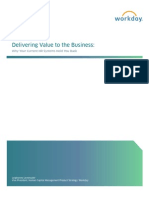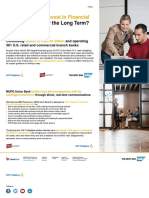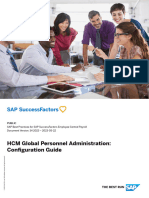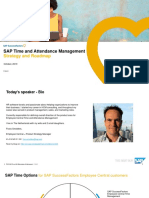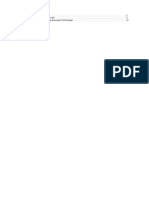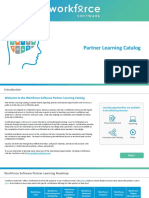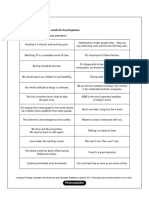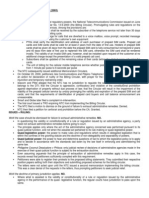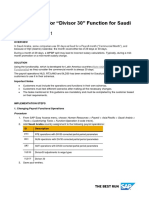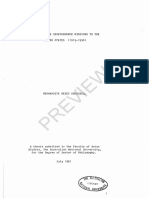Partner Implementation Guide
Uploaded by
Oscar DiazPartner Implementation Guide
Uploaded by
Oscar DiazPartner Implementation Guide
WorkForce Enablement Services Team
Updated March 2021
Partner Implementation Guide – March 2021
In This Document
Version History .......................................................................................................................................... 4
Welcome to Workforce Software! ................................................................................................................ 5
The WorkForce Partner Community Portal .............................................................................................. 5
Creating Cases ....................................................................................................................................... 5
Knowledge Base .................................................................................................................................... 6
Resources .............................................................................................................................................. 6
Ideas Portal ........................................................................................................................................... 7
WorkForce News and Partner Newsletters .......................................................................................... 7
Preparing for Your Project ............................................................................................................................ 8
Phase Detail............................................................................................................................................... 8
Resourcing Requirements and Planning ................................................................................................... 8
Requesting and Accessing Certification Training .................................................................................. 9
Benefits of Certification ........................................................................................................................ 9
Recertification ....................................................................................................................................... 9
Customer Training ................................................................................................................................... 10
Implementation / End User Training .................................................................................................. 10
Customer Certification Training .......................................................................................................... 11
The SI Authorization Letter ..................................................................................................................... 11
Accessing WorkForce Environments ....................................................................................................... 11
Client Environment Access.................................................................................................................. 12
VPN Access .......................................................................................................................................... 12
WorkForce Tenant Manager ............................................................................................................... 12
Database Access.................................................................................................................................. 13
FTP File Server Access ......................................................................................................................... 13
Partner Sandbox Access ...................................................................................................................... 14
Estimation ............................................................................................................................................... 14
The Plan Phase ............................................................................................................................................ 15
Standard Implementation Timeline ........................................................................................................ 15
The Confirm Phase ...................................................................................................................................... 16
WorkForce Software | info@workforcesoftware.com | workforcesoftware.com 2
Partner Implementation Guide – March 2021
The WorkForce Project Methodology..................................................................................................... 16
Base Product ....................................................................................................................................... 17
Extensions ........................................................................................................................................... 18
Customer-Specific Configuration ........................................................................................................ 18
Standard Product Questionnaires ....................................................................................................... 18
Product Assembly Instructions ........................................................................................................... 19
Models / Extensions ............................................................................................................................ 19
Base Product Usage Extensions Business Requirements Document .................................................. 19
Other Business Requirements Documents ......................................................................................... 20
Requirements Gathering ......................................................................................................................... 20
Potential Areas of Concern ..................................................................................................................... 20
WorkForce Suite Compatibility ........................................................................................................... 21
The Build Phase ........................................................................................................................................... 21
Planning a Build Phase ............................................................................................................................ 21
Beginning Configuration ......................................................................................................................... 22
Make Configuration Easy ........................................................................................................................ 22
First Project Audit – End of Build ............................................................................................................ 24
Enabling the WorkForce Suite................................................................................................................. 24
Integrations Documentation and Resources .......................................................................................... 25
Seeking WorkForce Approval for Non-Standard Configuration.............................................................. 25
The Validate Phase ...................................................................................................................................... 26
Migrating Policies and Making Backups.................................................................................................. 27
Test Plans and Test Case Tracking........................................................................................................... 28
Required Testing Before Go-Live ............................................................................................................ 28
Go-Live and Transition to Continuous Services (Support) .......................................................................... 29
A Note on Multiple Deployments ........................................................................................................... 29
The Pre-Go Live Audit ............................................................................................................................. 29
Go-Live .................................................................................................................................................... 30
Hypercare/Warranty ............................................................................................................................... 30
Transition to WorkForce Continuous Services (Support) ....................................................................... 30
Congratulations on a Successful Go-Live! ............................................................................................... 31
WorkForce Software | info@workforcesoftware.com | workforcesoftware.com 3
Partner Implementation Guide – March 2021
Version History
Date Description of Changes Updated By
2021-03-19 Initial version of document created WFS Enablement Services
WorkForce Software | info@workforcesoftware.com | workforcesoftware.com 4
Partner Implementation Guide – March 2021
Welcome to Workforce Software!
We are excited to have you join this journey in making work easy for you and our joint customers
around the globe. You are now part of our global partner community that will be using our workforce
management solutions to make work (life) easier.
At WorkForce Software, we are focused on ensuring the success of our implementation partners
through our Enablement Services Program. Enablement Services is required for all partner led projects
and focuses on coaching and mentoring partner teams through their WorkForce Software
implementations. Our goal is to have a network of experienced partners who deliver successful projects
to happy customers.
Throughout our partnership, we will work closely with you to support your projects to ensure you have
the correct resources to address questions and concerns as they arise. This Partner Implementation
Guide is a critical piece of this strategy and is designed to give you a “one-stop shop” for all the high-
level information you may need during any phase within the project lifecycle, from pre-planning all the
way through go-live and the transition to Continuous Services (Support).
Along with the support of your Enablement Services team, this document should be the first place you
look for information, as it contains a series of links to additional WorkForce resources that will provide
all the necessary details any member of the project team needs to carry out their work. This strategy of
“linking out” is meant to ensure that any changes to the product or to the WorkForce implementation
process are contained in the content we link to, reducing the risk of this Partner Implementation Guide
becoming out-of-date.
Thank you for partnering with us! We look forward to continuing this journey with you.
The WorkForce Partner Community Portal
The Community Portal is the best place to interact with Workforce. From within the Portal, you can
submit cases, find resources, download documentation, view recent WorkForce news, submit ideas and
ask questions. To access the WorkForce Partner Community, click here: Partner Community. From
within the portal, you have access to the following:
Creating Cases
If you need support from WFS, you can create a case using the following link: Open a Case. You can also
see existing and resolved cases opened by your organization here. For more information about the case
creation process, review the following Job Aid: Job Aid - Opening a Support Case
WorkForce Software | info@workforcesoftware.com | workforcesoftware.com 5
Partner Implementation Guide – March 2021
This document contains estimated completion times for some commonly requested cases: Cloud
Services Requests – Estimated Times for Completion.
To submit a request for a specific implementation configuration issue, you must have the appropriate
WorkForce certification relevant to the request. For example, to request assistance with an error in an
HR import script, you must have a current integrations certification.
Knowledge Base
We have put together different articles to provide guidance about our methodology and best practices.
Please click on the following link to find more information: Knowledge Base
Resources
WorkForce publishes dozens of documents and guides covering topics like gathering requirements,
configuration, training, and numerous others. Please click on the following link to access the
documentation section of the Community Portal: Resources
WorkForce Software | info@workforcesoftware.com | workforcesoftware.com 6
Partner Implementation Guide – March 2021
Additionally, as a new partner, we recommend that you review the following link: Service Partner
Welcome Packet eBook. It has very useful information to help understand our product, the WorkForce
implementation methodology, and the general processes to be followed to ensure a successful
WorkForce project.
Ideas Portal
At WorkForce, we’re always happy to receive ideas and enhancement suggestions from our ecosystem
of partners. Let us know what you’d like to see in the product by submitting your idea to our Ideas Portal
via the following link: Ideas Portal
Within the Ideas Portal, you can view, upvote, and comment on ideas submitted by other partners. The
WorkForce product teams utilize this resource as a part of their planning processes to determine the
needs the WorkForce partner community believes need to be addresses in the product. While the
submission of an idea in the portal does not guarantee a commitment on WorkForce’s behalf to update
the product, accordingly, submitting your ideas through the portal is the best way to get your thoughts
in front of the WorkForce product teams and the partner community at large.
WorkForce News and Partner Newsletters
New partner-facing content is added to the Partner Community Portal regularly. First, the News section
of the portal contains a list of blog posts that cover a range of topics including compliance-related
information, important legislation that may impact implementations, and tips and tricks to ensuring a
successful project. The News section of the portal can be accessed here: WorkForce News
Additionally, WorkForce publishes a partner newsletter every quarter called “WFS Partner Connection.”
These newsletters are sent out via email to all partners as they are published, but can also be accessed
via the Community Portal with the following link: WFS Partner Connection
WorkForce Software | info@workforcesoftware.com | workforcesoftware.com 7
Partner Implementation Guide – March 2021
Preparing for Your Project
One of the critical aspects of a WorkForce implementation is completing all necessary preparation
activities that will set the foundation for a successful engagement. These tasks touch on resource
acquisition, WorkForce certifications, environment access, and effort estimations. Each of these topics
will be reviewed below.
Phase Detail
WorkForce implementation projects are delivered in five sequential phases:
Plan: The Partner Sales and Procurement teams transition the project to the partner and the Customer
project teams.
Confirm: The Confirm phase is comprised of two stages of activities. The first stage occurs for Extension
functionality, and the second stage occurs for the definition and design of customer-specific
functionality.
Build: The partner configures the customer’s environment based on the approved design in stage two of
the Confirm phase as described above. The partner tests the configured behavior for adherence to the
customer’s requirements. The customer creates test cases and scripts for Acceptance Testing.
Validate: The customer performs User Acceptance Testing (UAT) to verify that the configuration meets
the documented requirements. Additional customer training also occurs for specific modules during this
phase.
Deploy: The customer executes the end-user training plan and the WorkForce Suite is rolled
out. Support of the application is transitioned to the appropriate production support teams. Lessons
learned and project closeout activities are also completed.
Resourcing Requirements and Planning
With the purpose of guaranteeing excellence in our implementations, WorkForce Software requires that
all projects are staffed with qualified, certified resources. At a minimum, this will include resources with
Functional certifications, Technical/Configuration certifications, and Integration certifications.
WorkForce Software | info@workforcesoftware.com | workforcesoftware.com 8
Partner Implementation Guide – March 2021
Depending on the details of your specific implementation, resources may require additional
certifications for WorkForce Advanced Scheduler (AS), WorkForce Forecasting and Scheduling (WF&S),
WorkForce Absence Compliance Tracker (ACT), or WorkForce reports.
Requesting and Accessing Certification Training
WorkForce offers both in-person and online certification training depending on the preferences and
needs of our partners. To access the WorkForce training catalog, course calendars, registration forms,
and the training content itself, you can connect to the WorkForce LMS via the following link: WorkForce
LMS. If you or a team member does not have access to the LMS, please reach out to the Training Team
at lmshelp@workforcesoftware.com. The team will provide access credentials to any users in your
organization requiring them.
Certification begins with Level 1 which focuses on foundational learning. Level 2 certifications are
achieved through advanced coursework. Certification translates to measured success for individuals as
each level deepens knowledge and experience. Exams are available at the completion of each course
within a certification level to validate team member’s knowledge.
Benefits of Certification
Over and above providing authorization to work on WorkForce projects in certified roles, there are a
host of other benefits that WorkForce certification provides:
• Access to the WorkForce Partner Community
• Free access to product update and release courses
• Ability to subscribe to the Partner on Demand Catalog for ongoing training needs
• Access to additional technical tools for technical roles
• Free annual recertification
• Ability to submit relevant cases
You can find more information about training and certifications accessing the Partner Training Catalog.
Recertification
WFS certifications are valid for one year. Recertification verifies that consultants who hold the WFS
product certification are keeping their knowledge of the product areas up to date. Certification grants
access to WFS resources and systems for project work. Access will not be granted to those who are
missing or have expired certifications.
WorkForce Software | info@workforcesoftware.com | workforcesoftware.com 9
Partner Implementation Guide – March 2021
Recertification is earned through completion of WFS Suite product update courses and exams. These
courses must be completed before your certification(s) expire and will be self-paced to conveniently
complete when needed. Please click on the following link to find more information: Partner WFS
Product Recertification Program. If any courses are missing from your training plan, please open a case
here: Create a Case.
Customer Training
During a WorkForce Software implementation, the customer will need to interact with the system at
each stage. To get the greatest benefit from the system, the customer must understand the
functionality available to them. Therefore, it is vital that training is delivered effectively during the
rollout. To fill this need, WorkForce offers two types of education for customers: Implementation / End
User Training and Customer Certification Training.
Implementation / End User Training
In this section we detail the training and demonstrations that is typically delivered as part of a full
implementation. WorkForce provides flexible training options including live on-site courses, real-time
online remote delivery, and self-paced eLearning. WFS best practices are to deliver content in a Train-
the-Trainer format so the customer can pass on the training to their employees. Some examples of
training delivery methods include:
• Partner develops and delivers all training for customer
• Partner purchases the WFS standard materials to deliver to customer – these can be edited
by the partner or customer to fit specific needs
• WFS can deliver standard live training to the customer on behalf of the partner
• Partner or customer contracts WFS to develop and deliver custom self-paced eLearning
modules
• Customer purchases self-paced eLearning subscription or modules to host in their own
Learning Management System (LMS)
Post-delivery, a customer can purchase an on-demand eLearning subscription for system admins or
payroll admins who are new and need to upskill.
WorkForce Software | info@workforcesoftware.com | workforcesoftware.com 10
Partner Implementation Guide – March 2021
Customer Certification Training
WorkForce Software recommends all customers have some team members complete our Customer
Certification courses. Courses can be taken during, and after, implementation for customers to learn to
take ownership over their systems and become self-sufficient. Typically, these courses are completed by
resources who internally support the WorkForce Suite. Customers directly supported by WFS are
required to have two certified resources, while this certification is optional for customers supported by
SAP. WFS is the only organization authorized to provide these courses to customers.
Additionally, WorkForce Cloud Services mandates that anyone who requires database access for any
reason must complete and pass the CT120 Database Schema Customer Certification course. This
required training should be planned and reviewed during the project kickoff and validated during the go-
live process to avoid delays in customer database access requests. For more information on required
customer training, see the following Knowledge Base article: Database Access for Customers
Please contact training@workforcesoftware.com if you wish to explore WFS training offerings further.
The SI Authorization Letter
As a part of all partner-led implementations, a System Integrator (SI) Agreement between the customer
and the implementation partner must be signed and submitted to WorkForce before a project can
commence. WorkForce provides three versions of this letter depending on the specifics of your project:
one for “standard” (non-SAP) deals, one for SAP deals, and a third version in Portuguese for our
customers in Brazil and Portugal. Copies of these documents can be found here: Customer Authorization
Letter.
The letter must include the names of the individuals who will be part of the implementation team. Once
completed, this agreement should be filed with WorkForce by submitting a case as described in the
“Client Environment Access” section below. WorkForce will verify that the named individuals are
appropriately trained and certified, and then they will be given access to the customer’s provisioned
environments.
Accessing WorkForce Environments
Access to WorkForce customer environments is restricted to trained, certified resources. Additionally,
several types of access can be requested depending on the needs of the implementation resource.
Everyone working on a project in a technical capacity requires access to WorkForce Tenant Manager, the
WorkForce VPN, and specific access to the client’s environments (development, test, production, or any
combination thereof). Additionally, some resources – including client resources - may require direct
WorkForce Software | info@workforcesoftware.com | workforcesoftware.com 11
Partner Implementation Guide – March 2021
database access or file system (FTP) access. Information on how to request access to each of these
systems is included below.
Client Environment Access
For consultants to be provided access to a client’s environment, an Enablement Services contract must
be signed, and a support ticket must be submitted to WorkForce via the WorkForce Partner Community
officially requesting access. As a part of this process, the SI Authorization Letter described previously
must be attached, which provides formal permission from the customer for the partner to access their
environments. To create a new ticket, click here: Create a New Case. For instructions on how to fill out
an Environment Access Request ticket, please view the following Knowledge Base article: Creating a
Client Environment Access Case. If you need to request access to multiple client environments or access
for multiple contractors, this can be done within a single case. Multiple cases are not required.
• NOTE: WorkForce limits the end date of access requests to be one year from the current date or
before. If access must be extended beyond this date, a follow-up case should be created several
days before the expiration is set to occur. WorkForce will not send a reminder of access expiring,
so it is highly recommended you set a reminder on your calendar as a prompt to submit a case
to renew your access.
VPN Access
To access Tenant Manager or the environment databases using a database client like DBVisualizer, the
use of a VPN is required. VPN access is granted whenever an environment access request is submitted to
an environment in a specific datacenter for the first time. For instance, if a consultant is working on a
project hosted in the US2 (Las Vegas) datacenter, VPN credentials for the Las Vegas data center will be
generated at the same time as access to the environment is granted. For a list of data centers, VPN links,
and WorkForce Tenant Manager information, please refer to the following reference list of links to VPN
(and Tenant Manager) instances.
Note: VPN access is not required to access WorkForce via the browser or the Policy Editor. In addition,
clients may not request VPN access; it is reserved for certified partners.
WorkForce Tenant Manager
WorkForce Tenant Manager is the application that WorkForce uses to store and maintain multiple SaaS
instances of Workforce Time and Attendance. You will interact with WorkForce Tenant Manager
frequently to:
WorkForce Software | info@workforcesoftware.com | workforcesoftware.com 12
Partner Implementation Guide – March 2021
• Start and stop environments
• Load copies of configuration from DEV to TEST or TEST to PROD
• Schedule certain jobs, such as data backups, as needed
• Access integration files, or download translation files
• Perform database queries, and create a database user who can perform more powerful queries
through an application like DBVisualizer
• Perform updates like patch updates (if needed; usually these are scheduled)
• Review a library of templates and access technical specs
Information on all these topics, and more, can be found in the following Guide: WTA 20.x Tenant
Manager Partner Guide. Additional best practices are documented in this Knowledge Base article:
WorkForce Tenant Manager Best Practices.
Database Access
Tenant Manager access and VPN access are both required for consultants to gain access to the database
for a customer instance. From within WorkForce Tenant Manager, two types of database access are
offered:
1. There is a feature within WorkForce Tenant Manager that allows users to run queries (SELECT
statements only) directly from the web.
2. Tenant Manager can be used to generate database credentials that can then be used in an external
database client. WorkForce recommends the use of DB Visualizer as a database client, which can be
purchased and/or downloaded from https://www.dbvis.com.
Detailed directions on how to utilize the above methods is contained in the Knowledge Base article here:
WorkForce Tenant Manager: Accessing an Environment Database.
FTP File Server Access
The FTP File Server is the repository for interface files used by the system’s imports and exports; for
instance, the HR Import and the Payroll Export files. WorkForce Tenant Manager provides consultants a
way to access the file system on WorkForce instances, but for the client’s systems and personnel to
access the FTP File Server, a ticket must be entered with WorkForce.
For information about accessing the file server via WorkForce Tenant Manager, review the Knowledge
Base article here: WorkForce Tenant Manager: Accessing the File Server.
For all other purposes, like connecting to the file server from a middleware solution like Boomi or CPI,
another software system, or an FTP client, you’ll need to request FTP credentials by opening a case with
WorkForce Software | info@workforcesoftware.com | workforcesoftware.com 13
Partner Implementation Guide – March 2021
WorkForce support. Directions for how to create such a case are contained in a Knowledge Base article
here: Creating a Client Environment Access Case.
Partner Sandbox Access
Authorized Service Partner Sandbox environments provide your organization with a place to test
potential solutions, have a Sandbox for training purposes, or demonstrate concepts to prospects and
customers. Partners receive one free sandbox environment per service delivery center. For more
information about Sandbox environments, please refer to the following document: Partner Sandbox
Guide
If you would like to request your organization's first free environment, complete the Authorized Service
Partner Sandbox Environment form on the WorkForce LMS (an LMS account is required). If you already
have a free environment and need access, please log a ticket in the WorkForce Community. Directions
for this can be found in the “Client Environment Access” section of this document. Contact the
WorkForce Training Team at lmshelp@workforcesoftware.com to verify if your organization has a
sandbox already or if you would like to purchase additional environments for an annual subscription fee.
Estimation
To proceed with your project, WorkForce must review and verify your estimate and resource plan.
Please reach out to your Partner Success Manager for further information.
Before moving to the Plan phase of your project, WorkForce recommends the
following actions have been completed:
✓ SI Authorization letter has been completed by client and submitted to WorkForce
✓ All authorized partner implementation resources have completed necessary certifications
✓ Access has been provisioned to the client’s environment for all authorized partner resources
✓ Project estimation and resource plan has been delivered and approved by WorkForce
WorkForce Software | info@workforcesoftware.com | workforcesoftware.com 14
Partner Implementation Guide – March 2021
The Plan Phase
The Plan phase of a WorkForce implementation project establishes a common understanding of the key
project objectives and expectations and builds the project governance structure to meet project goals,
including activities to be completed by the Customer and Partner project teams. Planning activities
include definition of the tasks and activities required to deliver the defined project scope, identification
of project dependencies and risks, assignment of project resources, and development of the initial
project plan to determine constraints and critical path. A formal project kick-off meeting is held to
introduce the project to the project team, create shared expectations, establish open lines of
communication, and promote active participation.
Standard Implementation Timeline
A typical WFS implementation lasts 6-9 months on average, with at least 6 weeks of user acceptance
testing (UAT). A complex implementation may take over a year, or even several years, if a phase
approach is required. Such a timeline may seem excessive, but the variety of configuration options
available in WorkForce, the coordination of multiple modules, and the depth and breadth of
customization potential in each client’s implementation warrants this. The following is a sample
workflow and timeline sample that can be customized to the specific needs of your project.
Project Workflow/Timeline Sample
Plan Confirm Build Validate Deploy
Project Timeline
Start Date: 3/1/2021
Mar Apr May Jun Jul Aug Sep
Week 1 2 3 4 5 6 7 8 9 10 11 12 BRD
13 14 15 16 17 18 19 20 21 22 23 24 25 26 27
Signoff
Pre Plan Plan SDD
Plan Signoff
Confirm Confirm Confirm Customer
Design
Confirm Base Extensions Specific Functionality
Site Visit
Core Build Build
Build
Build Base Extension
Initial
Full Validate
Validate Validation
End User
Training
Deploy
Initial Go/No Go
Signoff Decision
Click here to open a sample file you can edit:
2
WorkForce Software | info@workforcesoftware.com | workforcesoftware.com 15
Partner Implementation Guide – March 2021
NOTE: Partners must request advanced written approval from WorkForce Software on any project plans
with a total duration of less than 6 months.
Before moving to the Confirm phase of your project, WorkForce recommends the
following actions have been completed:
✓ Baseline project plan has been delivered and confirmed
✓ Communication Plan has been established
✓ Project resources have been requested and assigned
✓ Kickoff Meeting has been conducted
✓ Core Functionality training has been scheduled for key customer stakeholders
✓ Plan for Business Requirement Document and Solution Design development and review timeline
have been established
✓ (If DCTs/Clocks are in scope) Request has been submitted for badge samples
The Confirm Phase
Once all initial planning activities are complete, the partner and the customer will need to collaborate
on defining the business and technical requirements surrounding the WorkForce implementation. A
series of requirements gathering workshops will be held to guide the customer through the process of
selecting any necessary extensions to the Standard Product and to identify customizations that must be
implemented to meet the client’s business needs. WorkForce Software has developed a standard
methodology for use in eliciting requirements from customers and provides a library of documents
designed to assist with this process.
The WorkForce Project Methodology
The WorkForce Suite contains standard functionality alongside support for customer-specific
configuration to provide a complete business solution. The three layers of the standard product
functionality and custom configuration are described below.
WorkForce Software | info@workforcesoftware.com | workforcesoftware.com 16
Partner Implementation Guide – March 2021
Base Product
The WorkForce Suite comes pre-loaded with many common workforce management-related business
processes, calculations, and rules for complying with national and local regulations. This pre-defined
configuration serves as the foundation for the solution. Implementation partners will assist the
customer in completing the Customer Standard Setup Questionnaire to define settings for behavior in
the application’s base functionality within available parameters.
To familiarize the customer with the WorkForce Time and Attendance application, the implementation
team should complete the following steps:
1) Install the WorkForce Suite Base Product in the customer’s Test environment, using the parameters
that the customer selected in the WorkForce Software Base Setup Questionnaire. The questionnaire
should have been completed by the customer during pre-sales activities.
2) Load standard sample employee data to the system to enable the customer to log into and test the
functionality.
3) Train the customer on base functionality using the Test environment. It is best to begin with a
session to review WorkForce Suite terminology and basic functions.
4) Give the customer time to navigate and explore the Test instance to understand how the WorkForce
Suite functions.
5) The customer is responsible for reviewing this base functionality in detail. They should ensure that
the parameters they selected in their Base Product Setup Questionnaire are accurate and notify the
implementation team of any necessary changes.
6) It is critical to the success of the project for the customer to confirm that the base functionality is
correct and will not change as the project progresses. Additional policy profiles or other substantial
changes to the base functionality can require substantial rework and negatively affect your project’s
timeline and cost. The best practice of obtaining the customer’s sign-off before moving forward with
further configuration of extensions or customizations can help to prevent unexpected delays and
additional costs later in the project.
WorkForce Software | info@workforcesoftware.com | workforcesoftware.com 17
Partner Implementation Guide – March 2021
Extensions
The WorkForce Suite’s base functionality can be expanded upon by enabling Extensions. Extensions are
pre-built functional components that address specific business processes or calculations. The customer
selects the desired extensions with the partner’s assistance based on the customer’s knowledge of their
business requirements and rules.
Elements of the timesheet are affected when Extensions are implemented. How each Extension affects
the timesheet is described in general within each extension description. A complete list of descriptions
for available extensions within WorkForce is available at the following link: Model Functional Description
(MFD) Library – all items marked with “EXT” are extensions to the base product.
Customer-Specific Configuration
When Base Product and Extension functionality cannot be adopted or is incompatible with the
customer’s business needs, the creation of customer-specific configuration is necessary. WorkForce
strongly encourages the adoption of the WorkForce Suite’s Base Product and Extension functionality
wherever possible. This standard functionality represents WorkForce’s best practices and is the most
economical option for implementation and support of the WorkForce Suite. It can be implemented
more efficiently, and because it is supported by WorkForce’s Standard Product team, there is less risk to
the partner.
Standard Product Questionnaires
The Standard Product Questionnaires are used to capture the customer’s high-level business
requirements be found using the following searches:
• WorkForce Suite Customer Questionnaire: This brief document walks partners through the features
available in the WorkForce Suite and the configuration options and limitations of each feature.
• Customer Standard Setup Questionnaire: Several country-specific versions of this document are
available defining the various settings that can be configured as a part of the base product. Versions
exist for the United States, Mexico, and Germany, as well as a version that can be used with an
implementation in any country.
WorkForce Software | info@workforcesoftware.com | workforcesoftware.com 18
Partner Implementation Guide – March 2021
Product Assembly Instructions
The Product Assembly Instructions are step-by-step instructions on which product templates to install
and in what order to provide the base configuration for your implementation. These are designed to be
used by the implementation team after the questionnaires have been completed along with the client:
• Standard Product Assembly Instructions: Numerous country-specific versions of these assembly
instructions exist, including the Australia, Brazil, Denmark, Finland, France, Germany, Japan, Mexico,
the Netherlands, New Zealand, Poland, Saudi Arabia, Sweden, Thailand, UAE, and the US. More
versions are being added as WorkForce is implemented in new markets, so this list will grow over
time.
Models / Extensions
Hundreds of templates are available to easily integrate new functionality into your WorkForce
implementation without needing to create and link every individual policy by hand. The following
document collections provide all the functional and technical details needed to understand the available
template options:
• Model Functional Description (MFD) Library: Contains a comprehensive, detailed outline of every
WorkForce template available, including an overview, functional summary, calculations, examples,
and an explanation of configuration options.
• Country-Specific Functional Summaries: These are high-level summaries of the features contained
within each country-specific template described in the Standard Product Assembly Instructions.
Functional summaries exist for Australia, Brazil, Canada, Colombia, Denmark, Finland, France,
Germany, Japan, Mexico, the Netherlands, New Zealand, Poland, Saudi Arabia, Sweden, Thailand,
UAE, and the US. More versions are being added as WorkForce is implemented in new markets, so
this list will grow over time.
• Country-Specific Parameterized Capabilities: These documents are meant to accompany the country-
specific functional summaries described above and contain information about additional template
options and configuration settings that can be used in a WorkForce implementation. Versions of this
document exist for all the countries listed above.
Base Product Usage Extensions Business Requirements Document
The Base Product Usage Extensions BRD is a fillable Excel workbook containing multiple tabs broken
down by functional area, e.g., Worked Time Collection, Activity Tracking, and Compliance.
• Base Product Usage Extensions BRD: This document is designed to be used during the requirements
gathering process to capture the extensions that will need to be installed to meet the customer’s
WorkForce Software | info@workforcesoftware.com | workforcesoftware.com 19
Partner Implementation Guide – March 2021
business needs along with any business rules that require custom configuration. This document
should be completed before any Extensions are installed or custom configuration completed in the
customer’s environment.
Other Business Requirements Documents
Additional Business Requirements documents can be found using the following search:
• Business Requirements Documents (BRDs): These documents can be used to capture requirements
for integrations, data collection terminals, Absence Compliance Tracker (ACT), and Advanced
Scheduler (AS)
Requirements Gathering
It is the responsibility of the Functional Consultant to ensure the requirements are captured and
documented. For requirements related to integration and Data Collection Terminals (DCTs or time
clocks), they may rely on other consultants with expertise in those specific areas.
The following link contains a list of Knowledge Base articles that describe functional and technical best
practices. These articles provide information that can be useful when gathering requirements: Time and
Attendance Technical and Functional Best Practices topics (Including ACT).
Potential Areas of Concern
There are parts of the WorkForce Suite that are not designed to work together. For example, the
Advanced Scheduler tool is not compatible with employees who have multiple jobs (Multiple jobs may
also be referred to as “multiple assignments or concurrent assignments).
In other cases, two seemingly complex features work very well together if they are correctly configured.
A good example is the Absence Compliance Tracker Module, which is compatible with employees who
hold multiple jobs with a few configuration updates.
While gathering requirements, if you encounter any concerns about compatibility, reach out to your
WorkForce enablement team for advice.
WorkForce Software | info@workforcesoftware.com | workforcesoftware.com 20
Partner Implementation Guide – March 2021
WorkForce Suite Compatibility
The following Knowledge Base article contains a list of known compatibility limitations with the
WorkForce Suite. This article will be updated as new features are released.
WorkForce Suite: Current Compatibility Considerations
Before moving onto the Build phase of your project, WorkForce recommends that
the following actions have been completed:
✓ Business Requirements Documents and Solution Design Document are completed and signed off by
customer
✓ Partner has drafted a Configuration Plan
✓ Interface and data specifications have been communicated to customer
✓ Customer has assigned resources for test plan creation and ownership
✓ Gap analysis has been completed and any necessary Project Change Orders approved
The Build Phase
During the Build phase, the implementation team will configure the client’s environment using the
information contained within the Solution Design Documents completed and approved during the
Confirm phase. These documents contain all the necessary information required for WorkForce
configuration specialists to process with their work, including information on business rules, interfaces,
custom reports, and data collection terminals.
Planning a Build Phase
Along with your design documents, a configuration plan is critical. It helps you:
• Manage your team workload by assigning out tasks
• Helps you plan the time and resources you’ll need to build the configuration
• Gives everyone on the team visibility into the status of the build and what is/isn’t done
• Ensures configuration is done in the correct order
• Helps ensure everyone is working – (If someone finishes their configuration tasks, perhaps they
should be testing someone else’s)
Here is a link to a sample document you can download and customize for your own implementation:
Time and Attendance Config Plan
WorkForce Software | info@workforcesoftware.com | workforcesoftware.com 21
Partner Implementation Guide – March 2021
Beginning Configuration
Once you have an instance and a configuration design, you always begin by loading the most recent
Global Base Dataset. This dataset contains the necessary base policies for any configuration. Information
on how to load the dataset can be found in the following Knowledge Base article: How to Load the
Latest Global Base Dataset in Tenant Manager
Next, you want to load a Standard Product. This will be the first of many Extensions and Templates that
you may use. Instruction on template usage can be found here: How to use a Template. The Resources
section of the Community Portal contains Assembly Instructions for many countries and products. If
assembly instructions do not exist for the country you are configuring, use the Standard Product
Assembly Instructions. In addition, the corresponding Parameterized Capabilities document will provide
a good summary of what calculations and compliance policies are included in the version of the
Standard Product you have chosen.
To build beyond the standard product, you will use Extensions and Utility Templates, and if necessary,
custom configuration. Below are some useful reference links to refer to while configuring.
• Best Practices by Topic
• Distinguishing Between Extensions and Utility Templates
• Time and Attendance and ACT Configuration Best Practices
• Scheduling Best Practices
Make Configuration Easy
It’s very important to follow good commenting and documentation practices. Every template imported
or policy created should include a proper comment that identifies:
• Who created the policy,
• When the policy was created or
WorkForce Software | info@workforcesoftware.com | workforcesoftware.com 22
Partner Implementation Guide – March 2021
• How it has been changed, and
• Why the policy was created or changed – a direct reference to the requirement, UAT test failure,
change request, etc.
Below are some examples of good comments:
It is also important to use good comments when making changes within your formulas as well. Refer to
this article for commenting Standards: Standards for Comments in Policies
Comments help you, and your team, know why a policy exists or was changed and prevent mistakes
from occurring during later build stages or UAT. It promotes great communication within your team, and
even when working alone can save your future self a lot of time.
If comments are not in English (because it is not the project team’s primary language), make sure to
include English translations:
// 2016-11-30 JDoe
// cambió el contexto de la excepción de día a segmento
// y la etapa de cálculo de 006 a 012,
// a resolver conflictos con el premio de tiempo suplementario
// changed the exception context from day to slice
// and the calc stage from 006 to 012
// to resolve conflict with overtime premiums
WorkForce Software | info@workforcesoftware.com | workforcesoftware.com 23
Partner Implementation Guide – March 2021
This ensures that when your implementation transitions to WorkForce Continuous Services, they will be
able to read the comments and will not need to reach out to your project team for guidance after the
project’s conclusion.
First Project Audit – End of Build
When most of the configuration is complete and ready for a customer to start testing, you should
submit a request for your first project audit. The purpose of this review is to ensure the stability of the
configuration and check for certain issues that commonly can cause problems after a project goes live.
The second and final audit is performed when your project is nearly complete and ready to go live. The
following link includes the process for requesting an audit, what is reviewed, and what to do with the
results of the audit: Project Audit Overview and Procedure
Enabling the WorkForce Suite
Some additional configuration steps are required to enable the WorkForce Suite. To begin, follow the
instructions found in Appendix A of the WorkForce Suite Configuration Guide. Don’t forget that you will
need to complete the Suite training courses prior to configuring the Suite. For more information, refer to
the article WorkForce Suite Frequently Asked Questions.
A few other helpful Suite references:
• Hub and Assistant Card Breakdown: A high-level review of each Hub Card and Assistant Card in the
Suite, including configuration tips and testing advice.
• Troubleshooting Suite Password Issues: The WorkForce Integrated Suite brings all our products
together using one Central Authentication Service, allowing employees and managers to log into one
place to access all tools. The process for resetting passwords, user impersonation, and even
password complexity requirements are different with the Central Authentication Service than with
the individual applications. This article provides guidance on resolving some common password
problems encountered when using the Suite.
• WorkForce Suite Central Authentication Service (CAS) Overview: Customers using the WorkForce
Suite can take advantage of a simplified authentication service called the WorkForce CAS. This article
described how the CAS works and how to log into WorkForce T&A implementations that use it.
• Release Notes: The WorkForce Suite is updated every month; it’s a good idea to check these release
notes every month to stay up to date on current functionality.
WorkForce Software | info@workforcesoftware.com | workforcesoftware.com 24
Partner Implementation Guide – March 2021
Integrations Documentation and Resources
The following resources are of particular use to certified integrations consultants on your project. They
cover topics like the integration between Employee Central (SuccessFactors) and WorkForce, single sign-
on (SSO), WorkForce data APIs, and web services.
• WT&A Base Product Interfaces: This is the Standard Base Product Interfaces guide that provides
information on what interfaces are included with the base product templates, including a functional
description and basic use cases for each interface. Each version of WorkForce has a corresponding
guide, so be sure to download the version of the guide that matches the version of WorkForce your
team is implementing.
• SuccessFactors / WorkForce Implementation Guide: This provides information on what fields are in
scope for the standard SuccessFactors/WorkForce integrations, and a basic understanding of how
they work. Note that the SSO Section in that document is no longer valid – for SSO information see
the article listed in the SSO Options section. The UI SSO integration will need to involve WFS.
• Knowledge Base - Integration Best Practices: This knowledge base article provides a series of links to
integrations best practice articles, including configuration tips and configurations for the Employee
Central HR Import, the EC Payroll Export, and numerous other interfaces.
• WT&A WorkForce API Specs Guide: This guide documents the internal JavaScript APIs that can be
used to build custom interface scripts and perform specialized data processing.
• WT&A Web Services API Specs Guide: This document contains information on the SOAP web service
APIs that are available as a part of the Standard Product. SOAP web services are supported in all
versions of the WorkForce product.
• WorkForce Software Rest API Guide: This document contains information about how to use the next-
generation RESTful APIs that are available in the WorkForce Suite.
Seeking WorkForce Approval for Non-Standard Configuration
A ticket MUST be submitted to and approved by WFS to do any of the following items as they could
impact Go Live Approval:
• SQL Invocations: The use of SQL invocations is strongly discouraged in WorkForce configurations.
Because of the potential impact to system performance, all SQL invocations must be reviewed and
approved. Make sure you submit your requests well before your project goes live to avoid project
go-live delays.
• Use of Non-Conforming Scripts: Before version 17.3 of WorkForce Time & Attendance, the use of
WorkForce Java classes in interface scripts was permitted. However, this is no longer the case, and
approval for any such usages must be requested from WorkForce Software.
• Custom SOAP Web Services: In rare cases, the SOAP web services provided as a part of the product
are insufficient to meet a customer’s business and technical requirements. WorkForce Time and
Attendance supports the ability to create custom SOAP web services, but this requires the approval
WorkForce Software | info@workforcesoftware.com | workforcesoftware.com 25
Partner Implementation Guide – March 2021
of WorkForce Software’s go-live review board before a project can be moved into the production
environment.
• REST API Usage: The use of WorkForce REST APIs requires the client to be on version 20.2+ of
WorkForce Time & Attendance and also that the WorkForce Suite is enabled. If these criteria are
met, access to REST APIs can be enabled by the WorkForce Software team by following directions in
the linked document.
• Interfaces Running More Frequently Than Hourly: WorkForce best practice dictate that interface
scripts should not run more frequently than once per hour. For use cases where data must be
updated or fetched on a shorter interval, web services are typically a better solution. If scripts must
be used and truly require execution more frequently than once per hour, approval must be
requested from WorkForce.
• Setup of External SSO with the WFS Suite: The use of an external Single Sign-On (SSO) provider
requires WorkForce Software staff to configure access. Instructions on how to submit the case to
WorkForce are located behind the link.
Before moving onto the Validate phase of your project, WorkForce recommends that
the following actions have been completed:
✓ Functionality has been configured to the approved requirements
✓ Implementation Team QA has been completed and signed off by the technical lead
✓ Customer test plan has been delivered; testing schedule and resources have been established
✓ Actual data file for all import interfaces has been delivered to partner
✓ Issue identification and resolution process has been communicated to the customer
✓ Customer end user training plan has been completed and end user training has been scheduled
✓ Production Cutover / Go-Live Plan has been drafted
The Validate Phase
Once the initial configuration work has been completed for your project, testing is the final phase before
the project is ready to go live. Testing can refer to several distinct sets of activities:
• Quality Assurance Testing (QA): This is the testing done by the implementation team as a final step
of building a specific piece of configuration.
• System Integration Testing (SIT) / End-to-End Testing (E2E): The focus is on assuring that the
implementation meets stated requirements and all components of the system function together in
the designed way. This should be performed by the implementation team before User Acceptance
Testing and should be performed by the client before the system goes live.
• User Acceptance Testing (UAT): This is the testing done by the customer to ensure the
implementation meets business requirements. The client will develop their own test cases and
execute them against the system.
WorkForce Software | info@workforcesoftware.com | workforcesoftware.com 26
Partner Implementation Guide – March 2021
• Performance Testing: The goal of performance testing is to determine how the system functions
under a production-level volume of data, ensuring operations are completed within a reasonable
amount of time without negatively impacting system responsiveness. This includes loading a full
employee population, entering data on a typical number of timesheets, and exporting a full batch of
payroll for at least one pay cycle. Testing of other functionality and interfaces may also be required
as a part of performance testing, but the HR Import, time data, and Payroll Export must process
production-level data before the system goes live.
To assist partners with the QA and end-to-end testing phases, WorkForce has several Knowledge Base
articles available to describe best practices. A general testing best practices article can be found here:
Testing Best Practices, and individual topic-specific best practice articles also contain Testing sections
that will provide guidance on more targeted testing considerations. These can be found here: Best
Practices by Topic.
Migrating Policies and Making Backups
When preparing to begin UAT and turn the TEST environment over to the client, all the configuration
that exists in the DEV environment will need to be migrated to the TEST environment. The WorkForce-
recommended approach to migrating the configuration is as follows:
1. Conduct a “Policies Only” backup of the DEV environment in Tenant Manager
2. Load the backup into the TEST environment in Tenant Manager
3. Initialize the policy profile periods in the Policy Editor to match the client’s preferred system dates
4. Create any superuser accounts the client needs and assign them the required roles
5. Execute any LD Imports/Uploads, HR Imports, and any other imports the system requires to allow
the client to conduct testing
More information about how to create and load backups in Tenant Manager is located in the Tenant
Manager Partner Guide for your client’s software version here.
Once UAT has commenced, reported defects will need to be addressed in the DEV environment and fully
tested before being moved into the TEST environment. The WorkForce best practice for handling the
resolution of defects and eventual migration of corrected configuration is as follows:
1. Create a bundle in the DEV environment that will contain all the policies needing to be updated for
the specific issue in question. If using a ticketing system to track defects, the bundle name should
refer to the ticket number.
2. Make all necessary changes to the configuration in the DEV environment, ensuring that any added,
deleted, or updated policies are a part of the bundle.
3. Once configuration and testing of the changes in complete in the DEV environment, migrate the
bundle to the TEST environment using the Policy Migration Tool within the Policy Editor.
WorkForce Software | info@workforcesoftware.com | workforcesoftware.com 27
Partner Implementation Guide – March 2021
4. Once the defect has been confirmed corrected by the client, the bundle itself (but not the individual
policies within it) can be removed from the DEV and TEST environments to avoid clutter.
Test Plans and Test Case Tracking
A test plan and a testing tracking methodology need to be in place before the Validate phase is
underway. If you have questions about how to create a WorkForce Test Plan or wish to discuss best
practice around test case tracking, please reach out to the Enablement Services team at cse-
es@workforcesoftware.com.
Required Testing Before Go-Live
As mentioned elsewhere in this guide, the WorkForce Enablement Services (ES) Team conducts two
project audits during the lifecycle of a project (or each phase of a multi-phased implementation): one as
the Build stage is wrapping up, and another toward the end of User Acceptance Testing. As a part of the
second audit, an expanded focus is put on ensuring that comprehensive testing has taken place. If
evidence of comprehensive testing in the TEST environment is lacking, the WorkForce Go-Live Review
Board (GLRB) will not permit the project to go live.
The audit process and the GLRB require the following testing to have taken place in the TEST
environment before permission to go live is granted:
• All Policy Profiles should be locked, closed, and advanced at least once
• Over 50% of timesheets should have time entries in at least one period
• All imports and exports should have been executed without error at full production employee
volume
• Off-Cycle payroll should be tested if it is in scope
• Timesheet amendments must be created and approved at least once
Before moving onto the Go-Live phase of your project, WorkForce recommends that
the following actions have been completed:
✓ All critical testing issues must be resolved and approved, or a mitigation plan defined
✓ A Deployment Plan, Cutover Plan, and Production Support Plan are in place
✓ Customer acceptance and signoff has been achieved
✓ The Go-Live checklist has been completed and reviewed, and the cases to initiate the WorkForce go-
live process have been submitted
✓ The customer’s end user training has been completed
WorkForce Software | info@workforcesoftware.com | workforcesoftware.com 28
Partner Implementation Guide – March 2021
Go-Live and Transition to Continuous Services (Support)
Once testing has been completed and all outstanding issues have been resolved, several activities must
occur before the implementation can be migrated to the production environment and employees can
interact with the system. This section will outline these activities and will also describe the process of
transitioning to the WorkForce Continuous Services team once the production system has been running
smoothly for at least two pay cycles.
A Note on Multiple Deployments
A separate Go-Live Review Board meeting and Transition to WorkForce Continuous Services procedure
is expected for each individual project phase. A project phase is defined as any time you are delivering
into production:
• A new policy profile or employee population
• A new module, such as ACT or Advanced Scheduler, or Forecasting & Scheduling
• Enabling the Suite UI after the initial go live
• Additional functionality that could be considered risky such as new integrations or modifications to
existing integrations
• Changes to employees who are Live in the system
• Any other larger scale change to the production configuration
Smaller, one-off changes do not require a go-live review but should follow appropriate change
management methodologies. If in doubt, ask your Enablement Services team. The document Managing
Change in Customer Environments outlines the procedure that should be followed every time you are
making changes to a production environment.
The Pre-Go Live Audit
The WorkForce audit procedure applies to all projects and every phase of a multi-phased
implementation. Before a project phase goes live, The WorkForce Enablement Services team will
complete an audit of the configuration. The purpose of this review is to ensure the stability of the
configuration and check for certain issues that commonly can cause problems after a project goes live.
Any issues that are detected during this audit require resolution from the partner before the WorkForce
Go-Live Review Board (GLRB) will permit migration to production.
• Project Audit Overview and Procedure: This Knowledge Base article describes the go-live audit
procedure and list all the aspects of the configuration that the WorkForce Enablement Services
team will be reviewing.
WorkForce Software | info@workforcesoftware.com | workforcesoftware.com 29
Partner Implementation Guide – March 2021
• Brazil 1.510 Compliance Audit When configuring a solution to be used in Brazil that includes the
use of Data Collection Devices (clock), a standard solution must be used to comply with
Ordinance 1.510/2009. For these projects, a secondary review is completed by WorkForce
before the go-live to assess adherence with the 1.510 ordinance to ensure that a compliance
certificate can be issued.
Go-Live
The go-live process with WorkForce requires substantial preparation and collaboration with the
WorkForce Enablement, Support, and Cloud Services teams. The below documents outline the
necessary steps and should be reviewed at least six weeks in advance of the planned go-live date to
ensure enough time to complete all tasks.
• WFS Go-Live Process Overview: This document provides a high-level summary of the WFS Go-Live
process for System Integrator, including a numbered list of steps that must be taken.
• Go-Live Review Board FAQ: The purpose of the Go-Live Review Board (GLRB) meeting is to assess the
project’s overall Go Live readiness with the goal of minimizing post go-live issues that impact Support
and Cloud Services teams, not to mention overall customer satisfaction. This document provides a
list of frequently asked questions about this meeting.
• Data Clean-Up via Truncate Script: This script is always used as part of the initial go live process. It
can also be useful during other project phases. It offers a safe way to wipe employee and timesheet
data from your environment to start a new round of testing. This article provides a step-by-step
guide to creating your SQL update script, ensuring you delete the tables you want to delete and
retaining key data points.
Hypercare/Warranty
Hypercare is one of many terms for the period when a customer has started to use the application in
production but has not yet fully transitioned from the project team to support. During this time,
frequent minor configuration adjustments are common. WorkForce provides a Limited Support Process
to work with the project team to ensure the customer has the best possible experience. Through this
period, the project team remains as the customer’s first point of contact for any concerns they have.
Transition to WorkForce Continuous Services (Support)
The transition to WorkForce Continuous Services (Support) can occur when the customer has processed
two “clean” payrolls. A “clean” payroll is defined as a payroll run that is completed on time with no
WorkForce Software | info@workforcesoftware.com | workforcesoftware.com 30
Partner Implementation Guide – March 2021
major issues. While the process is somewhat different for SAP customers who will use SAP support to
the following documents outline this process:
• Overview Transition to Support (all customers): This provides a step-by-step overview of the tasks
that must be completed before a project can officially transition to WorkForce Continuous Services
(Support)
• Support Handoff Tollgate Checklist: This checklist will be filled out and handed off to the WorkForce
to the WorkForce Continuous Services Team (Support)
• Project Workbook Transition to Support: This is the workbook you will fill out and attach to your case
requesting a meeting to begin the Transition to WorkForce Continuous Services (Support)
Congratulations on a Successful Go-Live!
Once your project has transitioned to WorkForce Continuous Services, the implementation can be
considered complete. Congratulations!
We hope this guide has been helpful in navigating the WorkForce Software implementation process as a
valued partner. If there are any items we can improve upon or that need to be covered in this
document, please send us a message at cse-es@workforcesoftware.com. Your feedback is essential to
improving this document and the experience of WorkForce partners, so don’t hesitate to reach out.
WorkForce Software | info@workforcesoftware.com | workforcesoftware.com 31
You might also like
- SAP BP Quick Guide EC SetupDocumentGenerationNo ratings yetSAP BP Quick Guide EC SetupDocumentGeneration18 pages
- Integrating SAP Employee Central With WFSNo ratings yetIntegrating SAP Employee Central With WFS25 pages
- HCM - Oracle Recruiting Notification and Fast FormulasNo ratings yetHCM - Oracle Recruiting Notification and Fast Formulas58 pages
- Cross-System Workflow For SAP SuccessFactors SolutionsNo ratings yetCross-System Workflow For SAP SuccessFactors Solutions95 pages
- TMA00 WorkForce Time Attendance Core Functionality (2) (1) - 113236No ratings yetTMA00 WorkForce Time Attendance Core Functionality (2) (1) - 11323651 pages
- Workforce Central Timekeeper 5 User ManualNo ratings yetWorkforce Central Timekeeper 5 User Manual326 pages
- SAP731656 - ALP - SAP SuccessFactors Instance Strategy 1H 2022 PUBLICNo ratings yetSAP731656 - ALP - SAP SuccessFactors Instance Strategy 1H 2022 PUBLIC49 pages
- Configure Business Rules - SuccessFactorsNo ratings yetConfigure Business Rules - SuccessFactors4 pages
- Workday Delivering Value To The BusinessNo ratings yetWorkday Delivering Value To The Business8 pages
- SuccessFactors Concur Integration EnglishNo ratings yetSuccessFactors Concur Integration English1 page
- 1355 V11 201502 BestPractices SoftwareChangeManagement V4eNo ratings yet1355 V11 201502 BestPractices SoftwareChangeManagement V4e37 pages
- MUFG Union Bank Sap Fieldglass Contingent Workforce ManagementNo ratings yetMUFG Union Bank Sap Fieldglass Contingent Workforce Management3 pages
- HCM Global Personnel Administration Configuration GuideNo ratings yetHCM Global Personnel Administration Configuration Guide24 pages
- PeopleSoft Cumulative Feature Report HCMNo ratings yetPeopleSoft Cumulative Feature Report HCM114 pages
- IDP - Employee Central Core Hybrid - Employee Identifiers V1.7100% (1)IDP - Employee Central Core Hybrid - Employee Identifiers V1.722 pages
- HR Master Record (Mini-Master) /automatic Maintenance of Vendor Master RecordsNo ratings yetHR Master Record (Mini-Master) /automatic Maintenance of Vendor Master Records9 pages
- Oracle HCM Cloud - Time & Labor - TrainingCourseContants2100% (1)Oracle HCM Cloud - Time & Labor - TrainingCourseContants23 pages
- Feature Scope Description For SAP SuccessFactors Time TrackingNo ratings yetFeature Scope Description For SAP SuccessFactors Time Tracking15 pages
- Overview: Content: Travel Management Environment HR Master Data For Travel Management (Mini-Master)No ratings yetOverview: Content: Travel Management Environment HR Master Data For Travel Management (Mini-Master)8 pages
- NetDocuments Whitepaper DMS Best PracticesNo ratings yetNetDocuments Whitepaper DMS Best Practices18 pages
- SuccessFactors Recruitment Data Migration GuideNo ratings yetSuccessFactors Recruitment Data Migration Guide4 pages
- This Topic Covers User Accounts and User AuthorizationsNo ratings yetThis Topic Covers User Accounts and User Authorizations29 pages
- 3 - PT101 Implementation Methodology 2019 - 021603No ratings yet3 - PT101 Implementation Methodology 2019 - 02160389 pages
- Merative Social Program Management 8.1: Workflow Overview Guide100% (1)Merative Social Program Management 8.1: Workflow Overview Guide34 pages
- Birch Reduction: Pseudoephedrine to Methamphetamine Guide100% (4)Birch Reduction: Pseudoephedrine to Methamphetamine Guide6 pages
- Precalculus Concepts Through Functions A Unit Circle Approach To Trigonometry 3rd Edition Sullivan PDF DownloadNo ratings yetPrecalculus Concepts Through Functions A Unit Circle Approach To Trigonometry 3rd Edition Sullivan PDF Download324 pages
- SAT Math - Non Equations in 1 Var and System of Equations in 2 Vars - Hard RNo ratings yetSAT Math - Non Equations in 1 Var and System of Equations in 2 Vars - Hard R56 pages
- Edupadi Com Classroom Lessons ss1 Ict Application Area of Ict Page 2...No ratings yetEdupadi Com Classroom Lessons ss1 Ict Application Area of Ict Page 2...5 pages
- The Influence of Mindful Eating And/or Intuitive Eating Approaches On Dietary Intake: A Systematic ReviewNo ratings yetThe Influence of Mindful Eating And/or Intuitive Eating Approaches On Dietary Intake: A Systematic Review20 pages
- Making Hard Decisions With DecisionTools 3rd Edition Clemen Solutions Manual - Complete Set of Chapters Available For One-Click Download100% (14)Making Hard Decisions With DecisionTools 3rd Edition Clemen Solutions Manual - Complete Set of Chapters Available For One-Click Download44 pages
- SAP Note 1869401 - Configuration For Divisor 30 Function For Saudi PayrollNo ratings yetSAP Note 1869401 - Configuration For Divisor 30 Function For Saudi Payroll6 pages
- Philippine Independence Mission 1919-1934No ratings yetPhilippine Independence Mission 1919-193424 pages
- Optimization in Operations Research 2nd Edition Rardin100% (1)Optimization in Operations Research 2nd Edition Rardin313 pages
